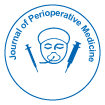
Journal of Perioperative Medicine
Open Access
ISSN: 2684-1290

ISSN: 2684-1290
Perspective - (2024)Volume 7, Issue 6
The field of surgical anesthesia has seen basic improvements with the integration of new technologies. These advancements have helped enhance patient safety, optimize anesthesia delivery, and improve the overall surgical experience for both patients and practitioners. This article explains some of the innovative technologies currently used in surgical anesthesia.
Advanced monitoring systems
One of the key improvements in surgical anesthesia is the development of advanced patient monitoring systems. Traditional monitoring systems focus on vital signs like heart rate, blood pressure, and oxygen saturation. However, newer technologies include devices that can monitor brain activity through Electroencephalography (EEG). This allows anesthesiologists to gauge the depth of anesthesia more accurately, ensuring that the patient is neither under-sedated nor over-sedated.
These systems can reduce the risk of anesthesia awareness (when a patient is partially awake during surgery) and minimize the side effects associated with excessive dosing. Continuous real-time monitoring of various parameters ensures that adjustments can be made quickly to maintain patient stability.
Target-Controlled Infusion (TCI) systems
TCI systems are another significant advancement. These devices use algorithms to calculate and administer precise doses of anesthetic drugs based on a patient’s unique characteristics such as age, weight and medical condition. By maintaining a steady concentration of the drug in the bloodstream, TCI systems provide a more consistent anesthetic effect compared to manual administration.
This technology not only helps achieve optimal sedation levels but also reduces the workload of anesthesiologists, allowing them to focus more on patient monitoring and overall care. TCI has shown to be especially beneficial in procedures that require a delicate balance of sedation over extended periods.
Smart syringe pumps
Smart syringe pumps are used for delivering a controlled amount of medication. These devices have built-in safety features to prevent dosing errors and ensure that the correct rate and volume of anesthesia are administered. The pumps are equipped with sensors and automated alerts that notify clinicians of potential issues such as air bubbles, blocked lines, or low battery power. This level of automation can significantly reduce human error and improve the safety of drug delivery during surgeries.
Anesthetic depth monitoring
Technologies that monitor the depth of anesthesia through brainwave patterns have become more accessible and reliable. Devices like Bispectral Index (BIS) monitors use EEG signals to create a numerical score that indicates the patient’s level of consciousness. This score helps anesthesiologists maintain an ideal state of anesthesia, balancing safety and comfort while minimizing the risk of postoperative cognitive dysfunction, particularly in older patients.
Artificial Intelligence (AI) and Machine Learning (ML)
AI and ML have started to play a role in predicting patient responses to anesthesia. By analyzing large datasets, these technologies can identify patterns that may not be obvious through traditional means. For example, AI can assist in creating personalized anesthesia plans that factor in patient history, drug metabolism rates, and potential complications. This helps improve the accuracy of dosage calculations and reduces the chances of adverse effects.
ML models can also provide recommendations during surgery, alerting the anesthesiologist to possible issues before they become critical. This proactive approach enhances decision-making and patient safety.
Non-invasive anesthesia delivery
Newer, non-invasive forms of anesthesia delivery are also being explored. These include transdermal patches and nasal sprays that offer an alternative to gas-based administration. Non-invasive delivery methods may be less intimidating for patients, particularly for those with needle phobia or difficulty with traditional masks. While these options are still under research and development, their potential could make anesthesia more accessible and improve patient comfort.
Portable anesthesia machines
Portable and compact anesthesia machines are another innovation making a difference, particularly in remote or emergency settings. These machines are designed to be lightweight and easily transportable, allowing anesthesia to be administered in locations without full operating room facilities. The mobility of these devices enables quick responses to situations that require immediate surgical intervention, whether in field hospitals, ambulances or other out-of-hospital settings.
Improved drug formulations
Beyond equipment, advancements in drug formulations have contributed to better anesthesia outcomes. The development of shorter-acting anesthetics allows for quicker patient recovery and reduces the duration of side effects such as drowsiness and confusion. These newer drugs are more predictable and easier to control, giving anesthesiologists more tools to customize the anesthesia plan based on the patient’s specific needs.
Innovative technologies in surgical anesthesia have enhanced the precision, safety and efficiency of anesthesia administration. From advanced monitoring systems to AI integration, these developments provide anesthesiologists with better tools for delivering safe and effective care. Continued research and adoption of new technologies will further contribute to improved outcomes, making surgeries safer and more comfortable for patients.
Citation: Liam M (2024). Innovative Technologies in Surgical Anesthesia. J Perioper Med. 07:251.
Received: 23-Oct-2024, Manuscript No. JPME-24-35270; Editor assigned: 25-Oct-2024, Pre QC No. JPME-24-35270 (PQ); Reviewed: 08-Nov-2024, QC No. JPME-24-35270; Revised: 15-Nov-2024, Manuscript No. JPME-24-35270 (R); Published: 22-Nov-2024 , DOI: 10.35841/2684-1290.24.07.251
Copyright: © 2024 Liam M. This is an open-access article distributed under the terms of the Creative Commons Attribution License, which permits unrestricted use, distribution, and reproduction in any medium, provided the original author and source are credited.